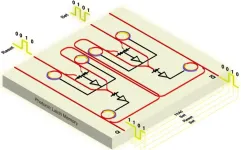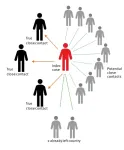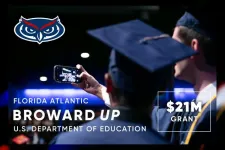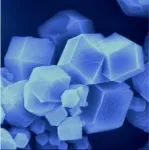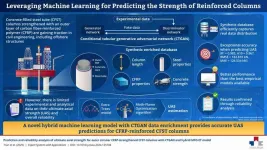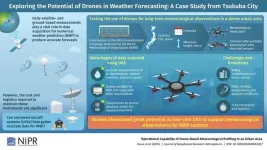(Press-News.org) Genetically tailored treatment plans for children with a type of kidney cancer could help provide the most effective care while minimising side effects as much as possible.
Researchers at the Wellcome Sanger Institute, Cambridge University Hospitals NHS Foundation Trust, Great Ormond Street Hospital, the University of Würzburg, and their collaborators, have mapped the genetic differences across children with a type of childhood kidney cancer called Wilms tumour.
In about 30 per cent of children with Wilms tumour, there is an inherited genetic change that increases the risk of developing this cancer. This study, published today (23 January) in Cancer Discovery, a journal of the American Association for Cancer Research, suggests that inherited genetic changes predetermine how these tumours develop, how much they respond to certain treatments, and whether the individual affected is at higher risk of secondary cancers later in life.
The team indicates that different genetic predispositions give rise to different tumour development pathways and kidney structures, and have identified those that restrict the growth of tumours. They also found that Wilms tumours develop differently in those without genetic predispositions.
Their findings suggest that tailoring treatment and screening programmes to a child’s genetic makeup could ensure that everyone is receiving the most effective care. In the future, this research could help develop new therapies for certain genetic changes and identify children who may need less invasive surgery.
Wilms tumour is a type of kidney cancer that largely affects children under the age of five. In the UK, about 85 children are diagnosed with Wilms tumour every year1.
While these tumours can occur through a spontaneous genetic change during development in the womb, in about 30 per cent of cases, an underlying genetic predisposition can increase the risk of developing Wilms tumour. Traditionally, children with Wilms tumour are screened for predisposition if they show specific features, such as tumours in both kidneys1.
Currently, treatment for Wilms tumour in predisposed children has to balance removing enough of the kidney tumour to help reduce the risk of secondary tumours later in life, while preserving as much kidney function as possible. Strategies to spare normal kidney tissue include chemotherapy, certain types of surgery, and extended courses of postoperative chemotherapy, along with close surveillance for recurrence.
The clinical management of children with a known predisposition differs from that of children with a spontaneous genetic change, due to the increased risk. By understanding more about how genetics influences the development of Wilms tumour, researchers could identify those with a lower risk of secondary tumours and use this to inform surgical approaches and screening programmes, as well as lead to the development of new therapies.
In this new study, researchers genetically mapped several hundred tissue samples from 137 children with Wilms tumour. This included 71 children who had a genetic predisposition, some of whom had early symptoms.
The team showed that tumour development differed in children with a genetic predisposition. This depended on which gene was affected and when this gene was activated during development in the womb, known as its developmental timing.
Different genetic predispositions to Wilms tumour were found to lead to specific DNA changes in childhood that caused tumour formation. These DNA changes are known as driver mutations, some of which increased the children’s risk of secondary cancers as well as Wilms tumour. In particular, genetic changes in genes – WT1 and TRIM28 – resulted in the accumulation of additional driver mutations in specific pathways, which could be targeted in future drug development.
Genetic predisposition also impacted the tissue architecture of the kidneys, which could help explain why some children develop non-cancerous kidney growths before cancerous tumours.
Overall, their findings indicate that predisposition may dictate how Wilms tumour develops, with specific patterns depending on the genetic change. Researchers suggest that in the future, it could be possible to tailor treatment and screening programmes to the type of genetic predisposition a child has, to ensure they are receiving the most effective care.
Dr Taryn Treger, co-first author at the Wellcome Sanger Institute, said: “Certain genetic changes that children are born with can predispose to Wilms tumour. What we show in our research is that cancers develop in different ways, depending on what the underlying genetic change is. This means that in some predispositions we can exactly predict what additional genetic changes lead to cancer development, paving the path to identify treatments that interfere with cancer formation in the first place.”
Phil Brace, Chief Executive of The Little Princess Trust, who supported this research, said: “Childhood cancer treatment can have substantial adverse effects that impact the child living with the condition, and those around them. We believe that it is crucial to fund studies that not only look for ways to improve a young person's chance of survival but also reduce the side effects from treatment. We are hopeful that this research may help tailor treatments in the future.”
Professor Sam Behjati, co-senior author at the Wellcome Sanger Institute and Cambridge University Hospitals NHS Foundation Trust, said: “Our research illustrates the power of collaborative genomic research to answer important clinical questions. At the moment, we treat all children with a predisposition the same, meaning that some children get too much and others too little treatment. Our findings indicate that we may be able to personalise treatment on the basis of genetic information. Moreover, since we now know the precise sequence of genetic changes that lead from predisposition to cancer, we may be able to screen for tumours more effectively and even begin to entertain the possibility of prevention.”
ENDS
Contact details:
Rachael Smith
Press Office
Wellcome Sanger Institute
Cambridge, CB10 1SA
07827979492
Email: press.office@sanger.ac.uk
Notes to Editors:
Cancer Research UK. Wilms tumour (nephroblastoma) web page. Available at: https://www.cancerresearchuk.org/about-cancer/childrens-cancer/wilms-tumour/about [Last accessed: December 2024]
Publication:
T. D. Treger, J. Wegert, A. Wenger, et al. (2025) Predisposition footprints in the somatic genome of Wilms tumours. Cancer Discovery.
Funding:
This research was funded in part by the Little Princess Trust and Wellcome. A full acknowledgement list can be found on the publication.
Selected websites:
About Cambridge University Hospitals
Cambridge University Hospitals NHS Foundation Trust (CUH) is one of the largest and best known trusts in the country, delivering high-quality patient care through Addenbrooke’s and the Rosie Hospitals. CUH is a leading national centre for specialist treatment for rare or complex conditions and a university teaching hospital with a worldwide reputation.
CUH is a key partner in Cambridge University Health Partners (CUHP), one of only eight academic health science centres in the UK, and is at the heart of the development of the Cambridge Biomedical Campus (CBC), which brings together on one site a range of organisations involved in world-class biomedical research, patient care and education. The Campus hosts the National Institute for Health and Care Research (NIHR) Cambridge Biomedical Research Centre.
The Wellcome Sanger Institute
The Wellcome Sanger Institute is a world leader in genomics research. We apply and explore genomic technologies at scale to advance understanding of biology and improve health. Making discoveries not easily made elsewhere, our research delivers insights across health, disease, evolution and pathogen biology. We are open and collaborative; our data, results, tools, technologies and training are freely shared across the globe to advance science.
Funded by Wellcome, we have the freedom to think long-term and push the boundaries of genomics. We take on the challenges of applying our research to the real world, where we aim to bring benefit to people and society.
Find out more at www.sanger.ac.uk or follow us on Twitter, Instagram, Facebook, LinkedIn and on our Blog.
About Wellcome
Wellcome supports science to solve the urgent health challenges facing everyone. We support discovery research into life, health and wellbeing, and we’re taking on three worldwide health challenges: mental health, infectious disease and climate and health. https://wellcome.org/
END
Predicting how childhood kidney cancers develop
2025-01-23
ELSE PRESS RELEASES FROM THIS DATE:
New optical memory unit poised to improve processing speed and efficiency
2025-01-23
WASHINGTON — Researchers have developed a new type of optical memory called a programmable photonic latch that is fast and scalable. This fundamental memory unit enables temporary data storage in optical processing systems, offering a high-speed solution for volatile memory using silicon photonics.
The new integrated photonic latch is modeled after a set-reset latch, a basic memory device used in electronic devices to store a single bit by switching between set (1) and reset (0) states based on inputs.
“While optical communications and computing have seen significant progress over the past decades, data storage has been predominantly implemented using electronic memory,” ...
World Leprosy Day: Tailored guidelines and reduced stigma needed to tackle leprosy, Irish case study reveals
2025-01-23
A case report published in Eurosurveillance on an adult with an imported case of leprosy in Ireland shows that there are notable challenges in tackling the disease in settings where it is rare. The affected individual was one of five individuals with leprosy reported in Ireland in the past decade. The authors report challenges faced in the public health response due to a delayed recognition of the symptoms by healthcare providers, a lack of specific Irish and European guidelines, and contact tracing in a congregate setting.
Ahead of World Leprosy Day, this case study highlights ...
FAU secures $21M Promise Neighborhoods grant for Broward UP underserved communities
2025-01-23
Despite South Florida’s reputation as paradise, the reality for many is stark. In the 2023-24 school year, Broward County reported more than 6,027 homeless children. The community also faces challenges like chronic absenteeism, mental health issues, poor nutrition, and limited access to quality early learning programs. These factors perpetuate a cycle of poverty and low educational attainment, hindering social mobility and the path to stronger communities.
To help address these issues, Florida Atlantic University has been selected as the recipient of a $21 million multi-year grant from the United States Department of Education Promise Neighborhoods ...
Korea-US leading research institutes accelerate collaboration for energy technology innovation
2025-01-23
The Korea Institute of Energy Research (KIER) signed a Memorandum of Understanding (MOU) with the U.S. Department of Energy’s (DOE’s) National Renewable Energy Laboratory (NREL) on January 9th to collaborate on key carbon-neutral technologies such as solar energy, hydrogen, and energy storage. The MOU was signed virtually via electronic signatures, with KIER President Chang-Keun Yi and NREL Director Dr. Martin Keller serving as the official signatories.
* NREL is a DOE national laboratory focused on the research and development of renewable energy and energy efficiency technologies, energy system integration, and sustainable transportation. NREL ...
JAMA names ten academic physicians and nurses to 2025 Editorial Fellowship Program
2025-01-23
Chicago, January 23, 2025 —JAMA today announces a new cohort of ten academic physicians and nurses selected for the JAMA Editorial Fellowship Program, designed to engage early career clinical or health services researchers with JAMA’s editorial team to learn about editorial decision-making and enhance skills in scientific communication.
Fellows were chosen based on their demonstrated interest in medical publishing, medical education or research, or a career in academic medicine, as well as their communication skills and knowledge of medical research and study design.
The 2025 JAMA editorial fellows are:
Hannah ...
New study highlights role of lean red meat in gut and heart health as part of a balanced healthy diet
2025-01-23
A recent study1 from Purdue University scientists reveals following a consistent dietary pattern that features lean red meat can contribute to gut microbiota balance and support cardiovascular health.
Balanced Diets with Lean Red Meat Support Gut and Heart Health
Researchers in the study assessed the effects of adopting and then intermittently stopping a healthy U.S.-style dietary pattern that included three ounces of lean red meat (beef and pork) daily in healthy young adults, a process called, “dietary pattern cycling.”
The ...
Microporous crystals for greater food safety – ERC proof of concept grant for researcher at Graz University of Technology
2025-01-23
It is a result of his ERC Consolidator Grant-funded project POPCRYSTAL, with which Paolo Falcaro from the Institute of Physical and Theoretical Chemistry at TU Graz has now acquired an ERC Proof of Concept Grant (PoC). The new project called FRESCO, which is being funded to the tune of 150,000 euros over a period of 18 months, aims to increase food safety and reduce food waste. This is made possible by a microporous crystalline composite developed as part of the POPCRYSTAL project, which detects toxic chemical compounds that are produced when ...
Offline versus online promotional media: Which drives better consumer engagement and behavioral responses?
2025-01-23
Marketers today increasingly rely on online platforms like mobile apps, social media, and direct email to deliver promotional content, drawn by their cost-effectiveness and extensive reach. However, despite these advantages, traditional offline promotion, such as printed coupons, might still outperform their digital counterparts in driving consumer behavior.
Offline media are reported to enhance consumers’ ability to recall promotional content and improve their perception of the advertised products. Yet, a direct comparison of how offline and online promotional media affect consumer behavior has remained largely unexplored.
To ...
Seoultech researchers use machine learning to ensure safe structural design
2025-01-23
In the quest for stronger, more resilient buildings and infrastructure, engineers are turning to innovative solutions, such as concrete-filled steel tube columns (CFST) strengthened with carbon fiber-reinforced polymer (CFRP). These advanced composite structures combine the robust load-bearing capabilities and strength of CFST columns with the lightweight, corrosion-resistant properties of CFRP. The result is a cutting-edge construction material that not only enhances structural performance but also offers increased durability and reduced maintenance.
Given the potential of ...
Empowering numerical weather predictions with drones as meteorological tools
2025-01-23
Climate change is making extreme weather events worse, empowering meteorological phenomena such as storms, hurricanes, heatwaves, and droughts. Against this backdrop, numerical weather predictions (NWPs), which use complex mathematical models that simulate atmospheric conditions, have become critical to protect people and businesses from these events and other weather-borne disasters.
Unsurprisingly, NWP models need a massive amount of daily data to make accurate predictions. While some of this data comes from satellite images and ground-based stations, a fine atmospheric vertical structure ...
